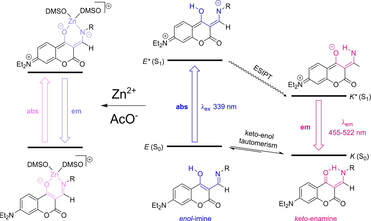
 Our work on the detection and qualitative discrimination of ion pairs using a coumarin-based receptor and excited-state intramolecular proton transfer (ESIPT) has been published in Inorganic Chemistry. This work describes the results of structural studies (X-ray, NMR) on an ESIPT-capable ligand upon metal binding, including the influence of the metal's counter-anion. We describe the origin of the observed significant Stokes shifts (ca. 225 nm) and lower-energy fluorescence emission (ca. 575 nm) upon metal binding, and the role of the metal's counteranion to induce deprotonation of the ligand. These ligands displayed markedly different behavior toward the considered ion pairs, behaving as dual-channel fluorescent sensors whose response could be harnessed through pattern-based recognition for simultaneous analytical discrimination of metal ions and anions alike.
Comments are closed.
|
Categories
All
Archives
March 2024
|

 RSS Feed
RSS Feed
